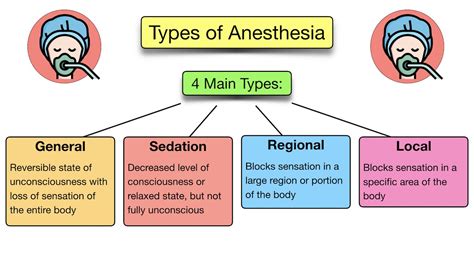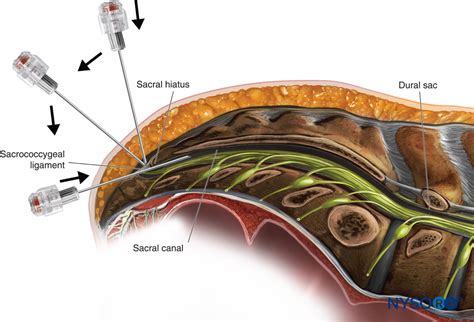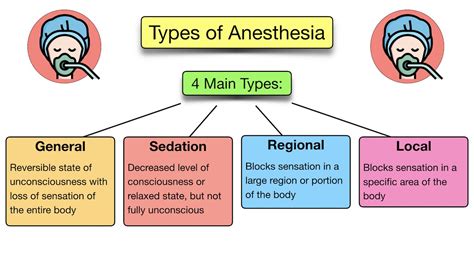Intro
Discover the 7 types of anesthesia, including local and general anesthesia, and learn how they work. From numbing injections to full sedation, understand the differences and risks associated with each type. Get informed about regional, epidural, and spinal anesthesia, and make an educated decision for your medical procedure.
Anesthesia is a crucial aspect of modern medicine, allowing patients to undergo surgical procedures with minimal discomfort and pain. However, with various types of anesthesia available, it can be overwhelming for patients to understand the differences between them. In this article, we will delve into the world of anesthesia, exploring the seven types of anesthesia and explaining the key differences between local and general anesthesia.

What is Anesthesia?
Anesthesia is a medical treatment that induces a temporary loss of sensation, allowing patients to undergo surgical procedures without feeling pain or discomfort. Anesthesia can be administered in various forms, including injections, inhalation, or oral medication. The primary goal of anesthesia is to ensure the patient's comfort and safety during medical procedures.
Types of Anesthesia
There are seven types of anesthesia, each with its unique characteristics and applications.
1. Local Anesthesia
Local anesthesia is a type of anesthesia that numbs a specific area of the body, typically for minor surgical procedures, such as biopsies or skin excisions. Local anesthesia is usually administered via injection or topical application, and its effects are limited to the targeted area.
2. General Anesthesia
General anesthesia is a type of anesthesia that induces a state of unconsciousness, making the patient unresponsive to pain and external stimuli. General anesthesia is often used for major surgical procedures, such as organ transplants or open-heart surgery.

3. Regional Anesthesia
Regional anesthesia is a type of anesthesia that numbs a larger area of the body, such as a limb or a section of the torso. Regional anesthesia is often used for surgical procedures, such as cesarean sections or orthopedic surgery.
4. Sedation Anesthesia
Sedation anesthesia is a type of anesthesia that induces a state of relaxation and drowsiness, making the patient less responsive to pain and external stimuli. Sedation anesthesia is often used for minor surgical procedures, such as colonoscopies or dental procedures.
5. Monitored Anesthesia Care (MAC)
Monitored anesthesia care (MAC) is a type of anesthesia that involves the administration of sedation and analgesia, while the patient remains awake and responsive. MAC is often used for minor surgical procedures, such as cataract surgery or skin excisions.
6. Spinal Anesthesia
Spinal anesthesia is a type of anesthesia that involves the injection of anesthetic medication into the spinal fluid, numbing the lower part of the body. Spinal anesthesia is often used for surgical procedures, such as cesarean sections or orthopedic surgery.
7. Epidural Anesthesia
Epidural anesthesia is a type of anesthesia that involves the injection of anesthetic medication into the epidural space surrounding the spinal cord, numbing the lower part of the body. Epidural anesthesia is often used for surgical procedures, such as cesarean sections or orthopedic surgery.

Local Vs General Anesthesia: What's the Difference?
Local anesthesia and general anesthesia are two of the most common types of anesthesia used in medical procedures. While both types of anesthesia are designed to reduce pain and discomfort, they differ significantly in their application and effects.
Local Anesthesia:
- Numbs a specific area of the body
- Typically used for minor surgical procedures
- Administered via injection or topical application
- Effects are limited to the targeted area
- Patient remains awake and responsive
General Anesthesia:
- Induces a state of unconsciousness
- Typically used for major surgical procedures
- Administered via inhalation or injection
- Effects are systemic, affecting the entire body
- Patient is unresponsive to pain and external stimuli

Benefits and Risks of Anesthesia
Anesthesia has numerous benefits, including:
- Reduced pain and discomfort during medical procedures
- Improved patient safety and comfort
- Enhanced surgical outcomes
However, anesthesia also carries risks, including:
- Allergic reactions to anesthetic medication
- Respiratory or cardiac complications
- Nerve damage or injury

Conclusion
In conclusion, anesthesia is a vital aspect of modern medicine, allowing patients to undergo surgical procedures with minimal discomfort and pain. Understanding the different types of anesthesia, including local and general anesthesia, can help patients make informed decisions about their care. By weighing the benefits and risks of anesthesia, patients can ensure a safe and successful medical procedure.

FAQs
What is the difference between local and general anesthesia?
+Local anesthesia numbs a specific area of the body, while general anesthesia induces a state of unconsciousness.
What are the benefits of anesthesia?
+Anesthesia reduces pain and discomfort during medical procedures, improves patient safety and comfort, and enhances surgical outcomes.
What are the risks of anesthesia?
+Anesthesia carries risks, including allergic reactions to anesthetic medication, respiratory or cardiac complications, and nerve damage or injury.
We hope this article has provided valuable insights into the world of anesthesia. If you have any further questions or concerns, please don't hesitate to reach out to us. Share your thoughts and experiences with anesthesia in the comments below!
